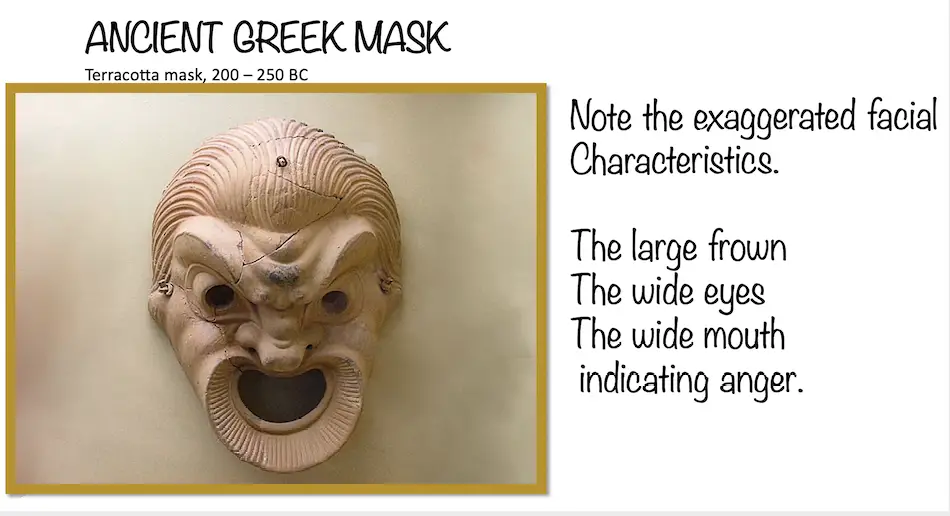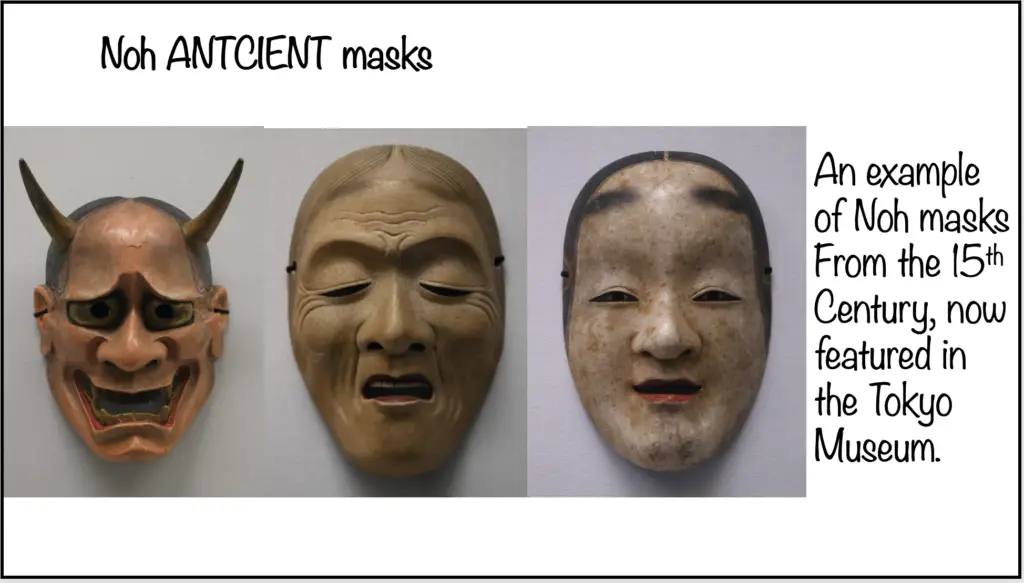Masks originated in Ancient Greek Theater with actors portraying humans with a socio-political and humorous effect. The Middle Ages utilized masks in Mystery plays, which featured and preached moral and religious themes. Other cultures such as Japanese, the European groups such as comedia del arte used masks to portray stock characters. Modern theater such as The Lion King to The Phantom use masks very effectively to achieve certain theatrical outcomes.
Masks In Ancient Theater – How did It All Begin?
Ancient Greek Theater used masks in religious portrayals of Gods (mainly the God of wine and fertility Dionysus). Where the people would come together and worship, dance and sing using massive props (of his phallus) and masks , while walking in a parade to signify the importance of the God and the rituals.
In the 5th Century, people began to worship Dionysus in the amphitheater called
The ‘Theater of Dionysus’ in which modern theater began.
The utlized the mask to portray characterisation in exaggerated and opulant ways. Usually masks were made out of leather or clay and shaped into a characters needed for an Amphitheater (outdoor arena).
Normally one actor would portray a number of roles on stage, which after some time, eventuanlly incorporated other actors and chorus of people.

If you would like to know more about where Comedy and Tragedy masks came from please check out my blog post here.
Noh Masks – Japan
The Noh masks of Japanese cultrue are unique in that they use a specific type of mask. They are a basic piece of the Japanese Noh Theater.
Noh masks are called omote in Japanese. They serve to portray a specific part in a play.
Noh plays only from time to time have more than 2-3 performers, and just the one actor who portrayus the main role (“shite”) in addition to his sidekick (“tsure”) wear these masks.
Noh means talent or skill. Noh theater performers tend to portray the essence of a character rather than reenact a person. It is known to represent a simile or metaphor.
The stories are usually well known in Japanese culture and so the audience enjoys seeing the eluding to their own culture being played out in front of them.

Noh actors usually made their own masks out of wood. Check out this video to learn more about Noh masks and theater.
If you are interested in the history of Puppetry please check on my blog post here.
Chinese Opera Theater Masks
Chinese opera used stock characters or tropes. These are archetypal characters that come back in every single production.
Those included the man, the woman, the clown, and the mysterious painted face, or ‘hua’.
Those characters, accompanied by their characteristic costumes that went with them, are still a staple of Chinese operas today.
Chinese operas have traditionally always been very popular, but throughout the communist era, it lost some momentum.
The specialty of the Chinese Sichuan Opera is the technique of rapidly switching masks and costumes. Check out the link here to see the masks and costume changes. Bian lian is the secret fast mask changes.
Comedia Del Arte
During the 16th and 18th Centuries, Italian theaters developed an improvised type of popular comedy theater basked on stock characters. Basic plots which often involved love themes and topical issues was staple. The characters would develop dialogue and actions in accordance with their stock character.
This type of theater was easy to mount and travel because actors needed few props and small set pieces.
Each stock characters had physical characteristics and looks which were universal. Here are examples of the most popular.
- Il Capitano: A Spaniard character who is a braggart and has swagger. Likes to show off his extreme importance. He loves to look at himself in the mirror, but is a coward and screams high pitched sounds.
- Harlequin: His chequered outfit distinguishes the Harlequin. He plays the character of a light-hearted, quick, and intelligent servant, frequently thwarting his master’s schemes and pursuing his own love interest, Columbina, with wit and cunning, often clashing with the sterner and melancholy Pierrot.
- Il Dottore: The Doctor is one of the vecchi, or “old men”, whose function in a scenario is to be an obstacle to the young lovers.
- Pantalone is “money” in the commedia sphere because of his extreme avarice and social status at the top.
Check out the video to show your ideas about what the masks look like.
What Masks are Iconic In Modern Theatre?
Vamos Theatre, based in Worcester, is the UK’s leading full mask theatre group.
With wit and sensitivity, the company has created four co-productions with London International Mime Festival, covering subject matter as diverse – and potentially dark – as dementia (Finding Joy), forced adoption (The Best Thing), post-traumatic stress (A Brave Face), and end-of-life (Dead Good).
Check out this video where actors don full face masks and portray characters using space, body language and action.
This play is based on the love between a grandmother an her teenage grandson and all the peculiarities around it.
Neutral Mask
Neutral Masks are a technique utilized in physical theater.
The neutral mask is a technique for increasing a performer’s awareness of their body language and nonverbal communication. A performer’s “presence” on stage is created by combining their posture, breath, centre of gravity, and relationship to space.
At The Theatre du Vieux Colombier in France, Jacques Copeau was the first to promote the idea of employing a neutral mask to train performers.
Copeau began with hoods, then moved on to a blank form before realising the need for a neutral mask. His students took this concept with them when they left his school.
Check out this website What makes a neutral mask, which shows you the how and why actors use masks to help with characterization.

The Phantom of the Opera
One of the most modern and iconic mask utlized in theater today is that from the musical opera show, The Phantom of the Opera.
The “Phantom’s,” Erik, puts a mask over his face to signify his fragility and the injustice he faces, since he is compelled to hide his face because it generates too much fear in others. Although the mask provides Erik some control over his life by allowing him to choose when to disclose his true identity, it also indicates that he has no control over one critical factor: other people’s emotions and reactions to his deformity.
Although it has long been employed as an ornamental device in art, the mask became widely seen as primarily a decorative object in the twentieth century.
Masks were mostly created for tourists in Haiti, India, Indonesia, Japan, Kenya, and Mexico. Ethnographers and artists alike continue to be fascinated by masks.
Afterthoughts
Masts in theater have been pivotal to storytelling and performance throughout the ages. From ancient Greek Theater to those from the Asian regions and more modern Western Theater. Actors and audiences alike still find the use of masks fascinating and interesting in theatrical storytelling. Once which is very likely to be utilized and transformed for theater for many years to comes.